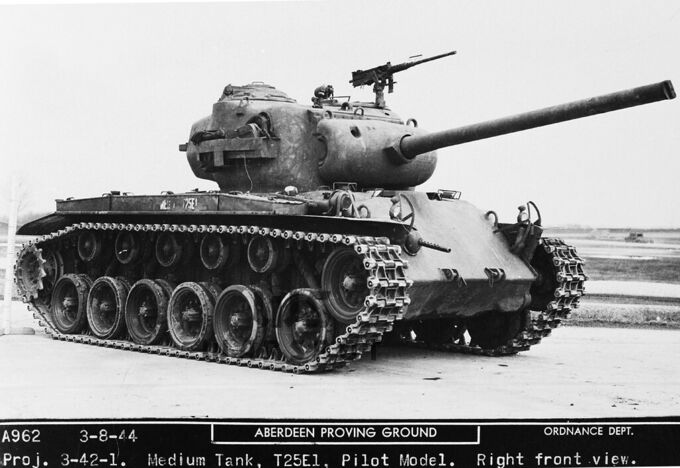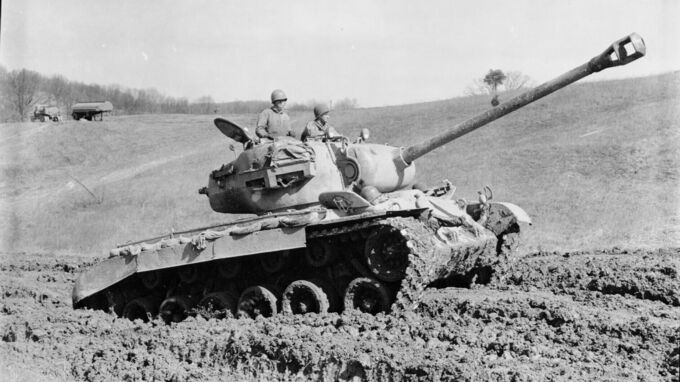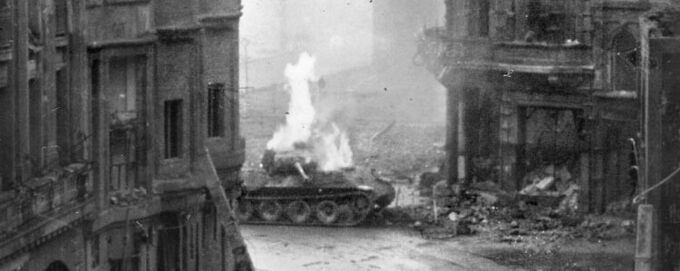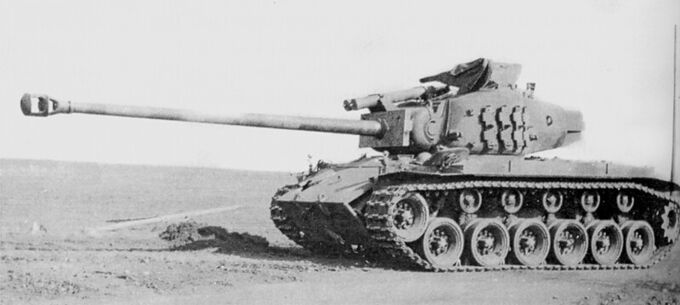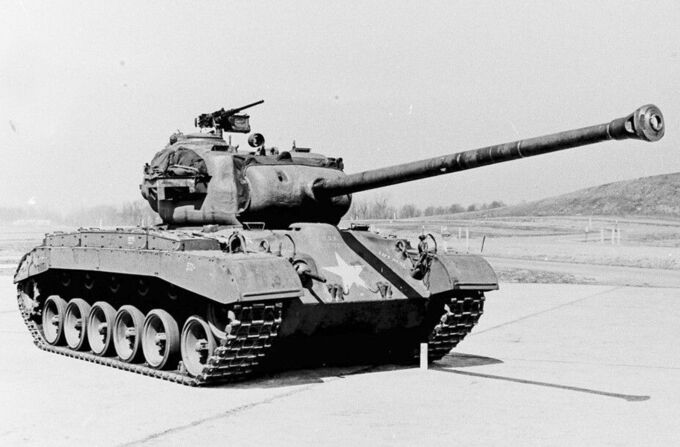Named after John J. Pershing, General of the Armies and mentor to many of the Generals that led America to victory during the Second World War, the M26 Pershing was the U.S. Army’s first heavy tank to see frontline service during the conflict. Although its service was limited, the Pershing proved to be one of the most important vehicles in U.S. military history for other reasons than its combat performance.
Design History
In 1942, the M4 Sherman began entering mass production in factories across the United States. Though this vehicle was highly capable and among the best of its class at the time, the Ordnance Department was already looking for a vehicle to replace it. Under the project title “M4X,” this new vehicle was to have approximately 100mm of frontal armor protection, weigh no more than 32 tons, and have a top speed of 25 mph. The prototype vehicles were labeled under the names T20, T22, and T23; all of which were essentially the same vehicle but mounted with different transmissions. However, all these vehicles had the transmission mounted in the rear of the vehicle, eliminating the need for a lengthy driveshaft and allowing the vehicle to be shorter and lighter.
Though the T20, T22, and T23 would not enter mass production, the T23 would be used for further testing as the Army gained interest in mounting a vehicle with the M3 90mm cannon, thus about forty T23 hulls were mated with a new turret. Vehicles that used the T23's original electric transmission were dubbed T25, whilst vehicles using a more standard torqmatic drive were named T25E1. These vehicles were tested alongside another batch of vehicles titled T26E1 which featured increased armor protection. During this testing the T25 and T25E1 were found to be insufficient, the former due to its complicated and untested electrical drive system and the latter because of experience gained in the European theatre demanding a heavier vehicle to counter Axis armor, thus the T26E1 was chosen as the most promising out of the trio.
The T26E1, while promising, still had quite a few teething problems, many of which would be resolved with the creation of the T26E3. This model featured increased ammunition capacity for the main gun, a muzzle brake to counteract the excessive amount of dust created when firing, and a series of mechanical improvements over the original model. However, an unresolved issue stemmed from the Ford GA engine installed in the Pershing. This engine produced 500 HP which was sufficient for vehicles like the T20 and M4A3 weighing around 30 tons, but struggled to power the T26E3 which weighed 10 tons more, resulting in poor mobility.
Service History
Under the direction of Major General Gladeon M. Barnes, Chief of Engineering and Research at the U.S. Ordnance Department, half of the new T26E3 tanks were sent to Fort Knox for standard trials while the others were sent overseas to Europe for combat trials under the Zebra Mission in order to resolve any further issues with the vehicle. Arriving in early January 1945, the first T26E3 vehicles were promptly assigned to the 12th Army Group under the command of General Bradley and were further divided amongst the 3rd and 9th Armored Divisions.
The T26E3, later redubbed as the M26 during March 1945 would see limited action during the war and mainly was used to provide fire support for infantry with sparse engagement with the remainder of Germany’s armored forces. The most famous tank engagement involving a Pershing was during 6 March, 1945 in Cologne which was caught on camera by Technical Sgt. Jim Bates.
During the Battle of Cologne, a Panther commanded by Oberleutnant Wilhelm Bartelborth positioned itself near the Cologne cathedral and ambushed a pair of Shermans advancing down a street, taking out the lead vehicle and killing three of the crew. In the next street over, a Pershing named Eagle 7 under the command of Sergeant Robert M. Earley received orders to engage the Panther. The gunner, Corporal Clarence E. Smoyer recounted the engagement in a later interview.
“We were told to just move into the intersection far enough to fire into the side of the enemy tank, which had their gun facing up the other street. However, as we entered the intersection, our driver had his periscope turned toward the Germans and saw their gun turning to meet us. When I turned our turret, I was looking into the Mark V gun tube; so instead of stopping to fire, our driver drove into the middle of the intersection so we wouldn’t be a sitting target. As we were moving, I fired once. Then we stopped and I fired two more shells to make sure they wouldn’t fire at our side. All three of our shells penetrated, one under the gun shield and two on the side. The two side hits went completely through and out the other side.”
Aside from this, the Pershing rarely did much during its time in service during the war. A post-war report going over the results of the Zebra Mission said “…German armor had been so crippled as to present a very poor opponent and the cessation of hostilities so soon after forming these companies precluded the gaining of any real experience.” Though many crews appreciated the increased protection and firepower the Pershing offered compared to the Sherman, the Pershing’s poor mobility and reliability issues soured opinions of the vehicle.
The M26 Pershing would later see active service again with the outbreak of war in Korea in 1950. The Pershing saw limited combat against DPRK forces using the T-34-85, with one engagement on 17 August 1950 having one Pershing engaging and destroying three of the Soviet vehicles. However, due to the mountainous terrain of Korea, the tank was quickly swapped out in favor of the M4A3E8 Sherman and the Pershing’s successor; the M46 Patton.
Pershing Variants
During and after the war, the Ordnance Department made a series of attempts to improve upon the Pershing’s lackluster performance by taking in the experience learned from the conflict and building a series of variants.
T26E1-1: The T26E1-1, otherwise more famously referred to as the 'Super Pershing' was a single prototype T26E1 that had its M3 cannon replaced with the T15E1. Although both of these guns had a bore diameter of 90mm, the T15E1 featured a longer barrel and larger ammunition. This gave the T15E1 far more armor penetration that was meant to counteract new German heavy tanks such as the Tiger II.
Note: T26 vehicles that were armed with the T51E1 or T51E2 were referred officially as the T26E4, but for this section the highly modified 'Super Pershing' will be referred to as the T26E1-1 to differentiate from the standardized T26E4.
This new cannon came with a series of new issues; due to the cannon’s excessive length and weight, a pair of springs were attached to the gun mantlet in order to help balance the gun and assist with elevating and depressing. To compensate for this increased weight at the front turret, a counterweight was added to the rear of the turret as well.
In a rare move by the Ordnance Department, the Super Pershing was sent overseas for an immediate combat trial; there further modifications were added to the T26E1-1. To enhance the vehicle’s armor protection, the T26E1-1 had an extra 80mm plate attached to the turret front salvaged from a Panther’s front plate, as well as additional armor plates attached to the front hull.
The T26E1-1 saw extremely limited service, with its only notable engagement being against what was assumed to be a Tiger II. After having a shell ricochet off its armor, the T26E1-1 returned fire, striking the lower front plate and causing an ammunition detonation. Later investigation would point to this vehicle likely engaging a Panzer IV as no Tiger IIs were recorded to be in the area at the time.
This unique vehicle met its rather unceremonious end as it was likely scrapped after being left in a vehicle dump in Kessel, Germany.
T26E5: As a result of the effectiveness of the M4A3E2, otherwise known as the 'Jumbo,' the Ordnance Department put out a design requirement for an up-armored assault tank variant of the T26E3 that was dubbed T26E5. Unlike the Jumbo which had armor welded onto existing Sherman hulls, the T26E5 was purpose-built from the factory to have increased armor protection, featuring an up-armored hull and turret immune to most anti-tank guns at the time.
To compensate for the added weight, 'duckbill' track extensions were to be added to the vehicle to reduce ground pressure. The same engine and transmission from the standard T26E3 were used, and in order to reduce strain on the drive system, the gear ratio was reduced. There were modifications to the T26E5's suspension to compensate for the increased weight, yet none of these modifications were apparently added before trials began.
When the T26E5 began trials, problems immediately arose involving the automotive and suspension components with the engine overheating and the torsion bars snapping under the increased strain. With the war’s end and the failure of the T26E5 to overcome its trial issues, most vehicles were used as target practice and all were either destroyed or scrapped.
M26E1: Outwardly, the M26E1 looks similar to a normal Pershing, but it has a lengthened cannon like the T26E1-1/T26E4. This cannon was the 90mm T54, which used a shorter propellant casing in comparison to the T51 cannon. The shorter casing allowed the crew to much more easily maneuver the shell in the turret, hastening the reload speed.
While this project looked promising, it was abandoned in favor of another Pershing upgrade.
M26E2/M46 Patton: The M26E2 was the final version of the M26. Instead of trying to improve on the firepower or armor, the designers instead sought to fix the mobility issues that had plagued the Pershing since its inception. They made many changes to the powerplant.
First and foremost, the 500 HP Ford GA was swapped out in favor of an 810 HP Continental AV1790-3. To create space for this much larger engine, the M26's old torqmatic transmission that fed into a differential was swapped out for an all-in-one CD-850 transmission which combined the transmission and differential into a smaller package.
Externally the only differences between the M26E2 and a standard M26 were the addition of a bore evacuator, an extra idler wheel at the rear of the vehicle, and a changed engine deck that had external exhaust pipes that fed into mufflers mounted on the track covers.
These upgrades gave the M26E2; later renamed to the M46 Patton increased mobility and reliability which greatly helped the Patton in the hilly terrain of the Korean peninsula and was more than a match for DPRK forces using lend-leased T-34-85s.
M26A1: Whilst many M26 Pershing’s were brought up to the new M46 standard, a lack of post-war funding meant that most were not able to receive the extensive automotive overhaul, thus some Pershing’s were simply upgraded with the new M3A1 cannon and were dubbed M26A1.
Legacy
The M26 Pershing during the Second World War served as more of a morale booster for Allied forces than an actual effective weapon on the battlefield. By the time it arrived, the dreaded Panzer divisions had been reduced to a shadow of their former power. This combined with the Pershing’s multitude of issues severely limited its impact in the conflict.
In the end, many Pershings would find themselves in the hands of allied NATO countries under the lend-lease program. This allowed the U.S. to clear its inventory of tanks it viewed as obsolete to make way for the newer M46 Patton and gave U.S allies access to a more modern vehicle.
Perhaps the Pershing’s greatest contribution though was the knowledge it provided to American tank designers in the post-war era. Many tanks built by the United States were based off of the Pershing chassis or a variant of it, some notable examples being the T34, M46, and M47 Patton.
(source: Armored Champion The Top Tanks of World War II by Steven Zaloga)


